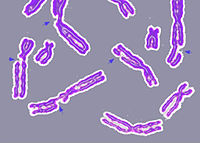
Photo from wikipedia
A cancer genome is a historical account of the mutagenic activity that has occurred throughout the development of the tumor. Indeed, every mutation matters. While driver mutations were the main… Click to show full abstract
A cancer genome is a historical account of the mutagenic activity that has occurred throughout the development of the tumor. Indeed, every mutation matters. While driver mutations were the main focus of cancer research for a long time, passenger mutational signatures, the imprints of DNA damage and DNA repair processes that have been operative during tumorigenesis, are also biologically informative (1-5). We previously outlined the methods for identifying and quantifying base substitution mutational signatures present in primary human cancers (1-5). Recently, the intellectual framework of mutational signatures was extended to include six novel rearrangement signatures (6). Exploring this in >2,500 whole genome-sequenced tumors of multiple tumor types reveals how our early (and rather simplistic) thinking of mutational signatures requires critical reevaluation. There are more nuances than previously appreciated. Diving into the detail of individual mutational signatures (7), we reveal intriguing mechanistic insights into the DNA damage and repair processes that mark the landscape of cancer genomes. In some instances, our findings invite more thoughtful consideration of that relatively binary distinction between drivers and passengers. Furthermore, we demonstrate why our whole-genome profiling methods could assist in taking things to a clinical level (6-8), with mutational signatures forming an additional weapon in the arsenal of cancer diagnostics and therapeutic stratification, in the modern war against cancer.References: 1. Nik-Zainal S et al. Mutational processes molding the genomes of 21 breast cancers. Cell 2012;149:979-93 .2. Nik-Zainal S et al. The life history of 21 breast cancers. Cell 2012;149: 994-1007. 3. Helleday T, Eshtad S, Nik-Zainal S. Mechanisms underlying mutational signatures in human cancers. Nat Rev Genet 2014;15:585-98. 4. Alexandrov LB et al. Signatures of mutational processes in human cancer. Nature 2013;500:415-21. 5. Alexandrov LB, Nik-Zainal S, Wedge DC, Campbell PJ, Stratton MR. Deciphering signatures of mutational processes operative in human cancer. Cell Rep 2013;3:246-59. 6. Nik-Zainal S et al. Landscape of somatic mutations in 560 breast cancer whole-genome sequences. Nature 2016;534:47-54. 7. Glodzik D et al. A somatic-mutational process recurrently duplicates germline susceptibility loci and tissue-specific super-enhancers in breast cancers. Nat Genet 2017;49:341-48. 8. Davies H et al. HRDetect is a predictor of BRCA1 and BRCA2 deficiency based on mutational signatures. Nat Med 2017;23:517-25. Citation Format: Serena Nik-Zainal. DNA damage signatures and practical use [abstract]. In: Proceedings of the AACR-NCI-EORTC International Conference: Molecular Targets and Cancer Therapeutics; 2017 Oct 26-30; Philadelphia, PA. Philadelphia (PA): AACR; Mol Cancer Ther 2018;17(1 Suppl):Abstract nr CN05-01.
Journal Title: Molecular Cancer Therapeutics
Year Published: 2018
Link to full text (if available)
Share on Social Media: Sign Up to like & get
recommendations!